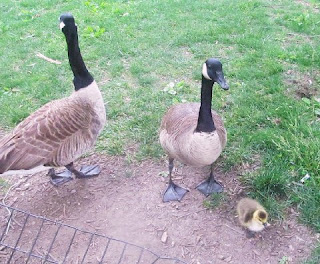While searching the entire Central Park boat lake yesterday for Danny, I came across two new goose families.
They consist of two mated goose pairs and a total of four newly hatched goslings --one couple with three babies and the other pair with only one.
But the new hatchlings seem more to add to the mystery of this season's goose hatchlings in Central Park rather than answer it.
Typically, a Canada goose lays from three to seven eggs with the average being five or six.
For a pair to have only one gosling suggests that either most eggs failed to hatch or there was high mortality in the goslings almost immediately after hatching. Three hatchlings is also a fairly low number suggesting some loss. (On this note, Greta at the CP Reservoir initially laid six eggs. One egg failed to hatch and two goslings were lost within the first ten days. Currently, three still survive.)
On the positive side, the presence of new goslings appears to suggest that little if any egg addling (i.e. rendering goose eggs unviable) was actually done in Central Park this season as has occurred in the past. (That was a question recently raised in light of recent high egg losses in CP this spring.)
The two families were in close proximity to each other with no strife or conflict. (This suggests that the two hens are likely related; perhaps sisters. It's also likely that the hens themselves hatched in Central Park and returned to the boat lake to start their own families with their mates. Hens usually determine nesting sites.)
It can be said that there is usually some safety in numbers. For the four goslings to have two sets of goose parents looking after them is a good thing (as well as the one lone hatchling to be exposed to other goslings). Hopefully, they can grow up similar to siblings.
The "bad news" in all this is that the two new goose families are located in a very crowded area of Central Park (near Bow Bridge) with much human activity around them.
There are tons of tourists, people in rowboats and unfortunately, fishermen who are often careless in leaving fishing lines and tackle around the lake. -- Things that can easily cause harm not only to tiny, vulerable goslings, but also, adult birds.
Yesterday, as the geese and their babies grazed in a grassy, fenced in area, one young woman reached over the fencing to pet one of the goslings like a kitten.
"You shouldn't do that," one woman corrected the girl. "They need to remain wild and be protected from people. That's why the fencing is here."
The young woman then pointed to a fisherman who was casting his line out to the water from inside the supposedly "off limits" area. He was mere feet from the two goose families.
"What about him?" she asked. "I mean the babies no harm!"
I then chipped in: "You may not mean harm to the animals, but other people do. The baby geese need to learn to be wary."
Of course it is hard to explain to people that they need to respect fenced-in protected areas when fishermen obviously don't.
With all the pressures and dangers around them, I am not at all optimistic that all four of the new goose babies will ultimately survive. (Already, their low numbers suggest some loss.)
Matters are particularly precarious for the one lone gosling without siblings. Perhaps this is the reason his/her parents have elected to stay close to the family with three hatchlings. Goose parents will do everything possible to protect their babies, but in Central Park, so much is out of their control. -- Especially, the actions of humans whether well intentioned or not.
Like everything else, much remains to be seen. Stay tuned. -- PCA
********









No comments:
Post a Comment